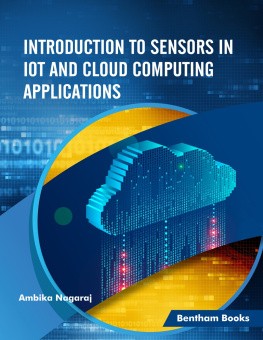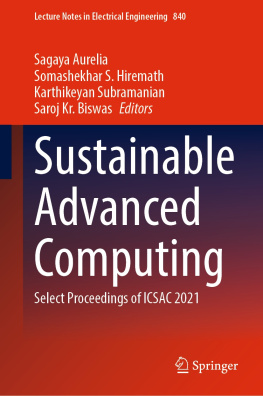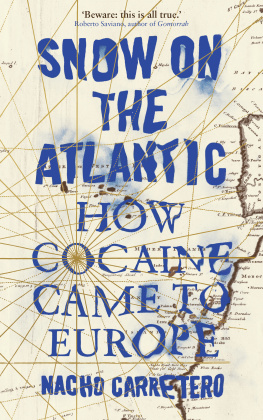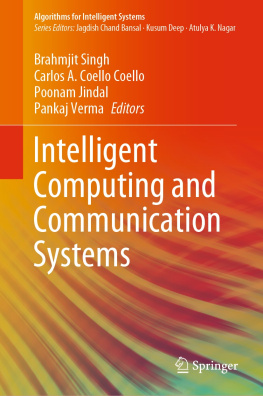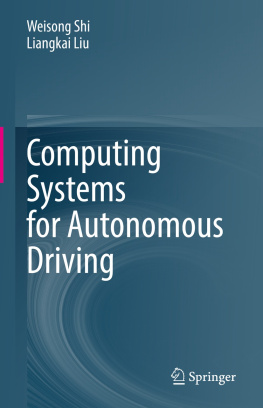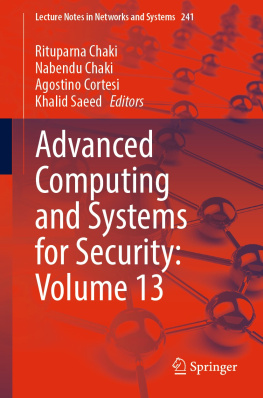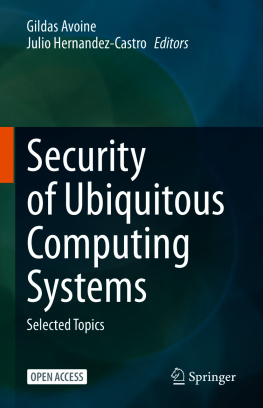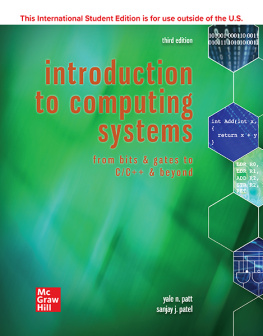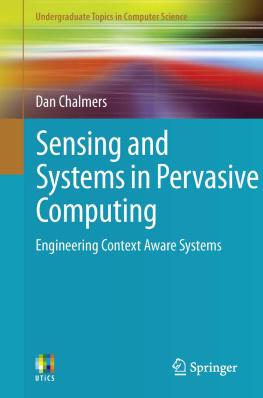Jesus Carretero - Ultrascale Computing Systems
Here you can read online Jesus Carretero - Ultrascale Computing Systems full text of the book (entire story) in english for free. Download pdf and epub, get meaning, cover and reviews about this ebook. year: 2019, publisher: Institution of Engineering & Technology, genre: Home and family. Description of the work, (preface) as well as reviews are available. Best literature library LitArk.com created for fans of good reading and offers a wide selection of genres:
Romance novel
Science fiction
Adventure
Detective
Science
History
Home and family
Prose
Art
Politics
Computer
Non-fiction
Religion
Business
Children
Humor
Choose a favorite category and find really read worthwhile books. Enjoy immersion in the world of imagination, feel the emotions of the characters or learn something new for yourself, make an fascinating discovery.
- Book:Ultrascale Computing Systems
- Author:
- Publisher:Institution of Engineering & Technology
- Genre:
- Year:2019
- Rating:4 / 5
- Favourites:Add to favourites
- Your mark:
- 80
- 1
- 2
- 3
- 4
- 5
Ultrascale Computing Systems: summary, description and annotation
We offer to read an annotation, description, summary or preface (depends on what the author of the book "Ultrascale Computing Systems" wrote himself). If you haven't found the necessary information about the book — write in the comments, we will try to find it.
Ultrascale Computing Systems — read online for free the complete book (whole text) full work
Below is the text of the book, divided by pages. System saving the place of the last page read, allows you to conveniently read the book "Ultrascale Computing Systems" online for free, without having to search again every time where you left off. Put a bookmark, and you can go to the page where you finished reading at any time.
Font size:
Interval:
Bookmark:
Introduction
Jesus Carretero
1Department of Computer Science and Engineering, University Carlos III of Madrid, Spain
2University of Applied Sciences of Western Switzerland, Switzerland
3Institut fr Informationstechnologie, Alpen-Adria Universitat Klagenfurt, Austria
4INESC-ID and Instituto Superior Tcnico (IST), Universidade de Lisboa, Portugal
With the spread of the Internet, applications and web-based services, distributed computing infrastructures, local parallel systems, and the availability of huge amounts of dispersed data, software-dependent systems will be more and more connected, more and more networked, leading to the creation of supersystems. The phrase ultrascale computing systems (UCSs) refers to this type of IT supersystems. UCSs are complex large-scale ecosystems aggregating high-performance parallel and distributed computing infrastructures. These systems provide to the end user intrinsically heterogeneous solutions, located at multiple sites and capable of delivering tremendous performance boosts. They are indispensable to applications offering several orders of magnitude increase in the size of data and in the computing power relative to today's existing conventional technologies. However, to really speak of UCS, we must consider several orders of magnitude increase in the size of data, in the computing power and in the network complexity relative to what is existing now.
By making explicit the characteristics of UCS, we better understand to which extent these systems are different from what exists today. The challenges that sustainable UCS posed require a change in perspective. We need to replace the satisfaction of requirements using traditional approaches based on rational top-down engineering by the orchestration of complex, decentralized systems. Moreover, building sustainable UCSs requires researching the entire stack from a holistic perspective to support them. Hardware, software, and middleware layers need to be jointly investigated to provide these large-scale distributed computing infrastructures with an ever-higher number of networked local parallel systems for efficient handling of the huge amounts of dispersed data.
This book is a result of the scientific cooperation held in a European Concerted Research Action, designated as COST Action IC1305: Network for Sustainable Ultrascale Computing (NESUS) []. The framework and the action are briefly described below.
COSTEuropean Cooperation in Science and Technologyis an intergovernmental framework aimed at facilitating the collaboration and networking of scientists and researchers at the European level. It was established in 1971 by 19 member countries and currently includes 35 member countries across Europe, and Israel as a cooperating state.
COST funds pan-European, bottom-up networks of scientists and researchers across all science and technology fields. These networks, called COST Actions, promote international coordination of nationally funded research.
By fostering the networking of researchers at an international level, COST enables break-through scientific developments leading to new concepts and products, thereby contributing to strengthening Europe's research and innovation capacities.
COST's mission focuses in particular on:
Building capacity by connecting high-quality scientific communities throughout Europe and worldwide;
Providing networking opportunities for early career investigators;
Increasing the impact of research on policy makers, regulatory bodies, and national decision makers as well as the private sector.
Through its inclusiveness, COST supports the integration of research communities, leverages national research investments, and addresses issues of global relevance.
Every year thousands of European scientists benefit from being involved in COST Actions, allowing the pooling of national research funding to achieve common goals.
As a precursor of advanced multidisciplinary research, COST anticipates and complements the activities of European Union (EU) Framework Programs, constituting a bridge toward the scientific communities of emerging countries. In particular, COST Actions are also open to participation by non-European scientists coming from neighbor countries (for example, Albania, Algeria, Armenia, Azerbaijan, Belarus, Egypt, Georgia, Jordan, Lebanon, Libya, Moldova, Montenegro, Morocco, the Palestinian Authority, Russia, Syria, Tunisia, and Ukraine) and from a number of international partner countries.
COST's budget for networking activities has traditionally been provided by successive EU RTD Framework Programs. COST is currently executed by the European Science Foundation (ESF) through the COST Office on a mandate by the European Commission, and the framework is governed by a Committee of Senior Officials (CSO) representing all its 35 member countries.
More information about COST is available at www.cost.eu. In particular, the COST Vademecum provides all the administrative and financial rules with respect to the management and implementation of COST Actions and associated activities. The COST Vademecum is a legally binding document approved by the ESF and follows the rules established by the CSO.
NESUS ran for the past four years, starting in 2014. Its main objective was to collaboratively rethink the development of current system software toward scalable computing systems to contribute to a future sustainable growth and to improve coordination of efforts between complementary communities. While the scientific community supports the emergence of Exascale systems, companies and researchers are engaged in efforts of scaling data centers and system software to meet the requirements of cloud applications and services. There is already some level of cross-domain interaction, for example, in high-performance computing (HPC) in clouds or on the adoption of distributed programming paradigms such as Map-Reduce for scientific applications. However, a stronger cooperation between HPC and distributed systems communities for the construction of ultrascale systems is of utmost importance.
Thus, NESUS Action followed on a cross-community approach of exploring system software and applications for enabling a sustainable development of future high-scale computing platforms. In detail, the Action work was focused in the following scientific tasks:
First, the current state of the art on sustainability in large-scale systems has been studied. The Action strives for continuous learning by looking for synergies among HPC, distributed systems, and big data communities in cross cutting aspects such as programmability, scalability, resilience, energy efficiency, and data management.
Second, the Action explores new programming paradigms, runtimes, and middleware to increase the productivity, scalability, and reliability of parallel and distributed programming.
Third, as failures will be more frequent in ultrascale systems, the Action looks for new approaches of continuous running in the presence of failures, trying to find synergies between resilient schedulers that handle errors reactively or proactively, monitoring and assessment of failures, and malleable applications that can adapt their resource usage at runtime.
Fourth, future scalable systems will require sustainable data management for addressing the predicted exponential growth of digital information. The Action explores synergistic approaches from traditionally separated communities to reform the handling of the whole data life cycle, in particular, restructure the Input/Output (I/O) stack, advance predictive and adaptive data management, and improve data locality.
Font size:
Interval:
Bookmark:
Similar books «Ultrascale Computing Systems»
Look at similar books to Ultrascale Computing Systems. We have selected literature similar in name and meaning in the hope of providing readers with more options to find new, interesting, not yet read works.
Discussion, reviews of the book Ultrascale Computing Systems and just readers' own opinions. Leave your comments, write what you think about the work, its meaning or the main characters. Specify what exactly you liked and what you didn't like, and why you think so.


